Environmental Sustainability in Construction: Strategies and Analysis
VerifiedAdded on 2020/05/04
|9
|2333
|239
Report
AI Summary
This report focuses on environmental sustainability within the construction industry, emphasizing the crucial role of low/zero carbon design. It examines the significant carbon footprint of construction, from material production to building demolition, and highlights key design aspects to mitigate environmental impact. The report explores strategies such as selecting low-carbon materials (e.g., timber), incorporating renewable energy sources, promoting material reuse and recycling, and improving construction processes and energy management. Climate-responsive designs and life-cycle considerations are also discussed as integral components of low/zero carbon strategies. The selection of low-carbon materials, innovative construction processes, efficient energy consumption management, and the use of renewable energy systems are analyzed, along with the importance of recycling and reusing construction materials to minimize carbon production. The report emphasizes the need for sustainable practices to reduce the construction industry's environmental impact, advocating for a shift towards a more sustainable and environmentally friendly approach.
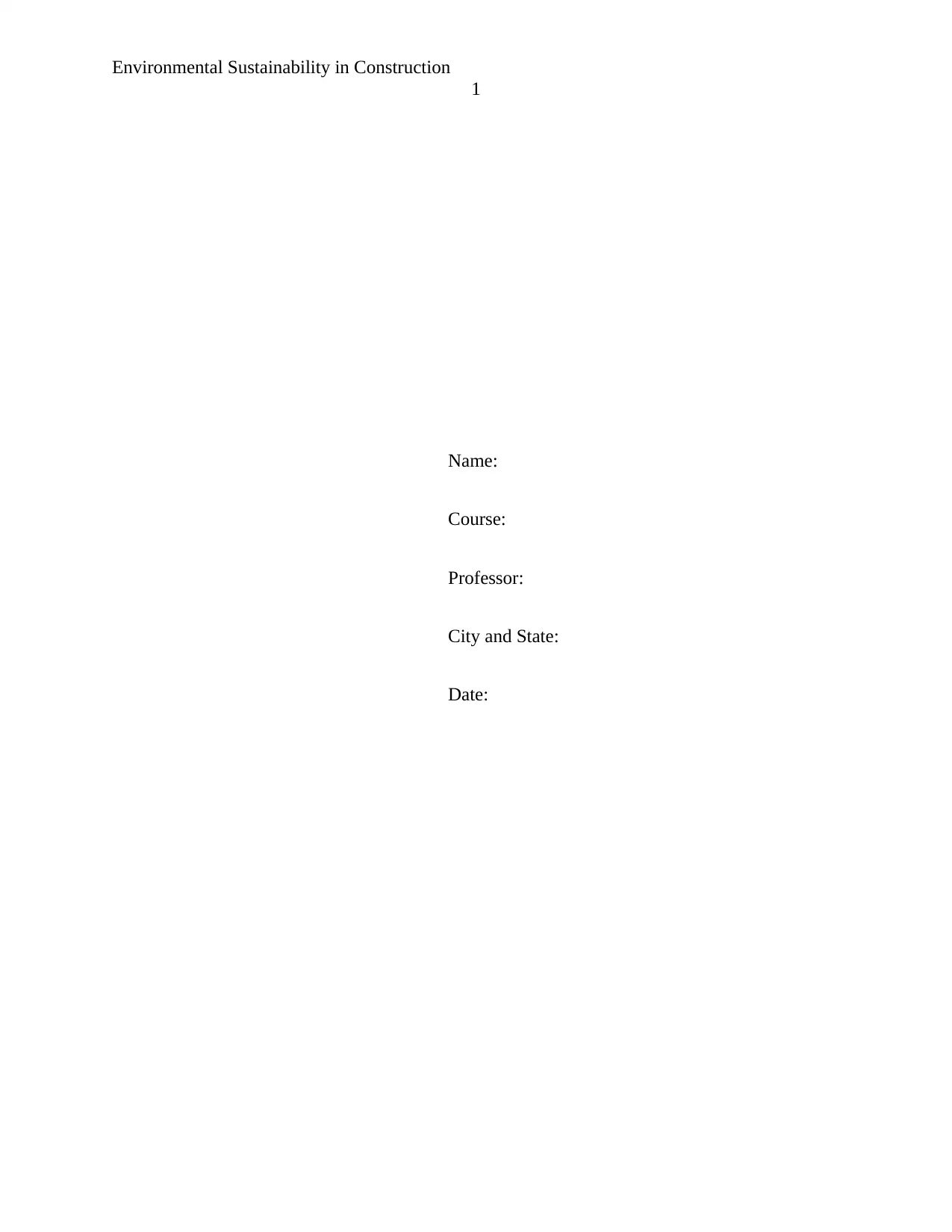
Environmental Sustainability in Construction
1
Name:
Course:
Professor:
City and State:
Date:
1
Name:
Course:
Professor:
City and State:
Date:
Paraphrase This Document
Need a fresh take? Get an instant paraphrase of this document with our AI Paraphraser
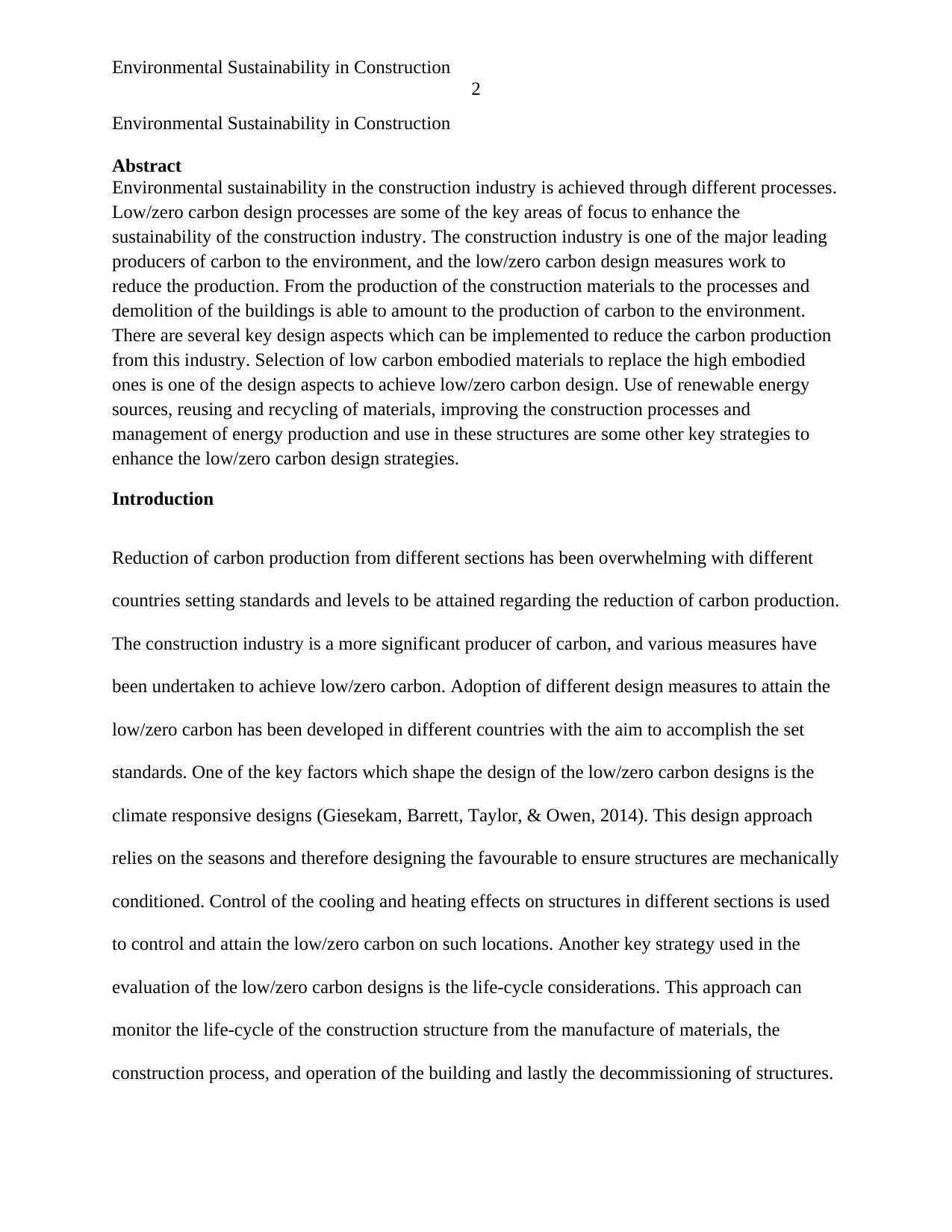
Environmental Sustainability in Construction
2
Environmental Sustainability in Construction
Abstract
Environmental sustainability in the construction industry is achieved through different processes.
Low/zero carbon design processes are some of the key areas of focus to enhance the
sustainability of the construction industry. The construction industry is one of the major leading
producers of carbon to the environment, and the low/zero carbon design measures work to
reduce the production. From the production of the construction materials to the processes and
demolition of the buildings is able to amount to the production of carbon to the environment.
There are several key design aspects which can be implemented to reduce the carbon production
from this industry. Selection of low carbon embodied materials to replace the high embodied
ones is one of the design aspects to achieve low/zero carbon design. Use of renewable energy
sources, reusing and recycling of materials, improving the construction processes and
management of energy production and use in these structures are some other key strategies to
enhance the low/zero carbon design strategies.
Introduction
Reduction of carbon production from different sections has been overwhelming with different
countries setting standards and levels to be attained regarding the reduction of carbon production.
The construction industry is a more significant producer of carbon, and various measures have
been undertaken to achieve low/zero carbon. Adoption of different design measures to attain the
low/zero carbon has been developed in different countries with the aim to accomplish the set
standards. One of the key factors which shape the design of the low/zero carbon designs is the
climate responsive designs (Giesekam, Barrett, Taylor, & Owen, 2014). This design approach
relies on the seasons and therefore designing the favourable to ensure structures are mechanically
conditioned. Control of the cooling and heating effects on structures in different sections is used
to control and attain the low/zero carbon on such locations. Another key strategy used in the
evaluation of the low/zero carbon designs is the life-cycle considerations. This approach can
monitor the life-cycle of the construction structure from the manufacture of materials, the
construction process, and operation of the building and lastly the decommissioning of structures.
2
Environmental Sustainability in Construction
Abstract
Environmental sustainability in the construction industry is achieved through different processes.
Low/zero carbon design processes are some of the key areas of focus to enhance the
sustainability of the construction industry. The construction industry is one of the major leading
producers of carbon to the environment, and the low/zero carbon design measures work to
reduce the production. From the production of the construction materials to the processes and
demolition of the buildings is able to amount to the production of carbon to the environment.
There are several key design aspects which can be implemented to reduce the carbon production
from this industry. Selection of low carbon embodied materials to replace the high embodied
ones is one of the design aspects to achieve low/zero carbon design. Use of renewable energy
sources, reusing and recycling of materials, improving the construction processes and
management of energy production and use in these structures are some other key strategies to
enhance the low/zero carbon design strategies.
Introduction
Reduction of carbon production from different sections has been overwhelming with different
countries setting standards and levels to be attained regarding the reduction of carbon production.
The construction industry is a more significant producer of carbon, and various measures have
been undertaken to achieve low/zero carbon. Adoption of different design measures to attain the
low/zero carbon has been developed in different countries with the aim to accomplish the set
standards. One of the key factors which shape the design of the low/zero carbon designs is the
climate responsive designs (Giesekam, Barrett, Taylor, & Owen, 2014). This design approach
relies on the seasons and therefore designing the favourable to ensure structures are mechanically
conditioned. Control of the cooling and heating effects on structures in different sections is used
to control and attain the low/zero carbon on such locations. Another key strategy used in the
evaluation of the low/zero carbon designs is the life-cycle considerations. This approach can
monitor the life-cycle of the construction structure from the manufacture of materials, the
construction process, and operation of the building and lastly the decommissioning of structures.
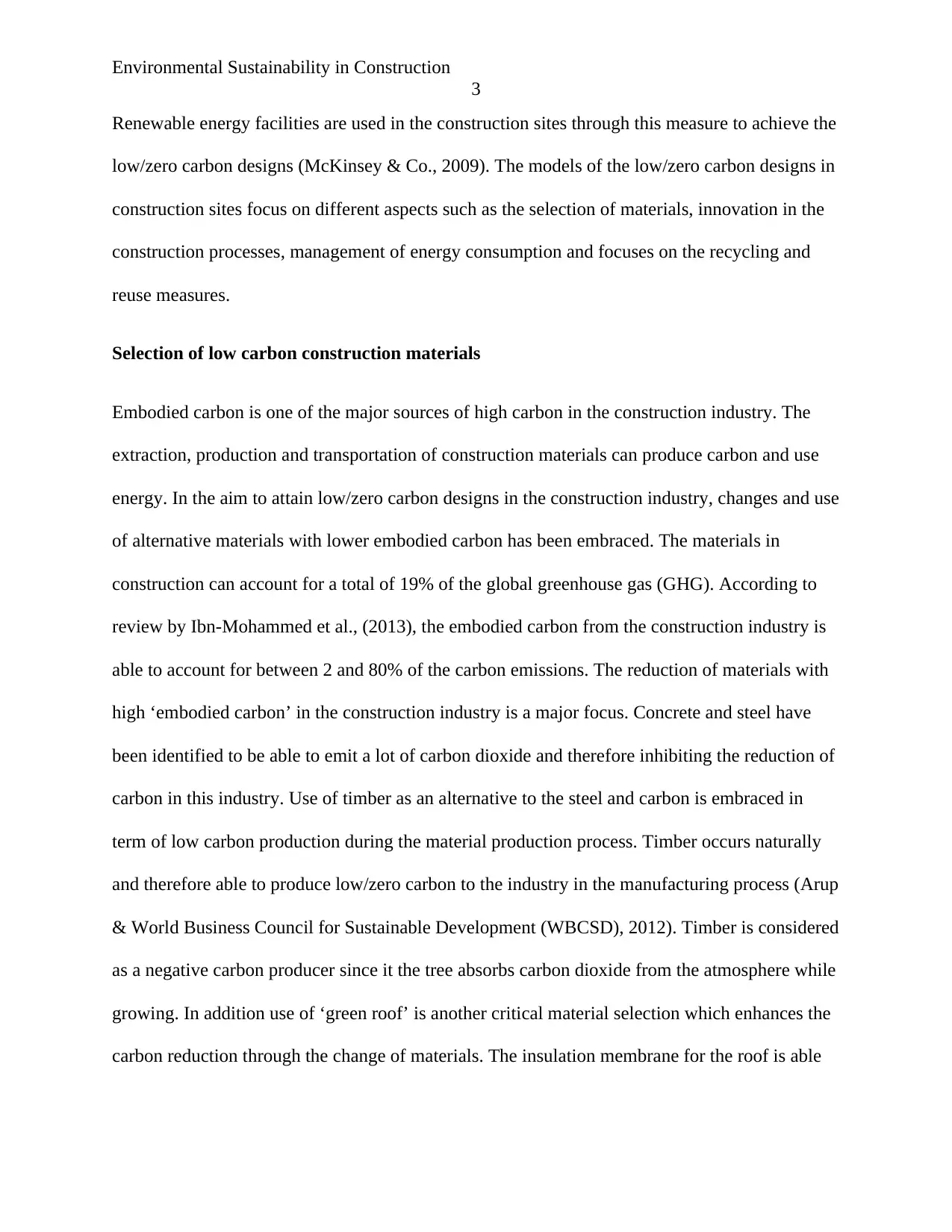
Environmental Sustainability in Construction
3
Renewable energy facilities are used in the construction sites through this measure to achieve the
low/zero carbon designs (McKinsey & Co., 2009). The models of the low/zero carbon designs in
construction sites focus on different aspects such as the selection of materials, innovation in the
construction processes, management of energy consumption and focuses on the recycling and
reuse measures.
Selection of low carbon construction materials
Embodied carbon is one of the major sources of high carbon in the construction industry. The
extraction, production and transportation of construction materials can produce carbon and use
energy. In the aim to attain low/zero carbon designs in the construction industry, changes and use
of alternative materials with lower embodied carbon has been embraced. The materials in
construction can account for a total of 19% of the global greenhouse gas (GHG). According to
review by Ibn-Mohammed et al., (2013), the embodied carbon from the construction industry is
able to account for between 2 and 80% of the carbon emissions. The reduction of materials with
high ‘embodied carbon’ in the construction industry is a major focus. Concrete and steel have
been identified to be able to emit a lot of carbon dioxide and therefore inhibiting the reduction of
carbon in this industry. Use of timber as an alternative to the steel and carbon is embraced in
term of low carbon production during the material production process. Timber occurs naturally
and therefore able to produce low/zero carbon to the industry in the manufacturing process (Arup
& World Business Council for Sustainable Development (WBCSD), 2012). Timber is considered
as a negative carbon producer since it the tree absorbs carbon dioxide from the atmosphere while
growing. In addition use of ‘green roof’ is another critical material selection which enhances the
carbon reduction through the change of materials. The insulation membrane for the roof is able
3
Renewable energy facilities are used in the construction sites through this measure to achieve the
low/zero carbon designs (McKinsey & Co., 2009). The models of the low/zero carbon designs in
construction sites focus on different aspects such as the selection of materials, innovation in the
construction processes, management of energy consumption and focuses on the recycling and
reuse measures.
Selection of low carbon construction materials
Embodied carbon is one of the major sources of high carbon in the construction industry. The
extraction, production and transportation of construction materials can produce carbon and use
energy. In the aim to attain low/zero carbon designs in the construction industry, changes and use
of alternative materials with lower embodied carbon has been embraced. The materials in
construction can account for a total of 19% of the global greenhouse gas (GHG). According to
review by Ibn-Mohammed et al., (2013), the embodied carbon from the construction industry is
able to account for between 2 and 80% of the carbon emissions. The reduction of materials with
high ‘embodied carbon’ in the construction industry is a major focus. Concrete and steel have
been identified to be able to emit a lot of carbon dioxide and therefore inhibiting the reduction of
carbon in this industry. Use of timber as an alternative to the steel and carbon is embraced in
term of low carbon production during the material production process. Timber occurs naturally
and therefore able to produce low/zero carbon to the industry in the manufacturing process (Arup
& World Business Council for Sustainable Development (WBCSD), 2012). Timber is considered
as a negative carbon producer since it the tree absorbs carbon dioxide from the atmosphere while
growing. In addition use of ‘green roof’ is another critical material selection which enhances the
carbon reduction through the change of materials. The insulation membrane for the roof is able
⊘ This is a preview!⊘
Do you want full access?
Subscribe today to unlock all pages.

Trusted by 1+ million students worldwide
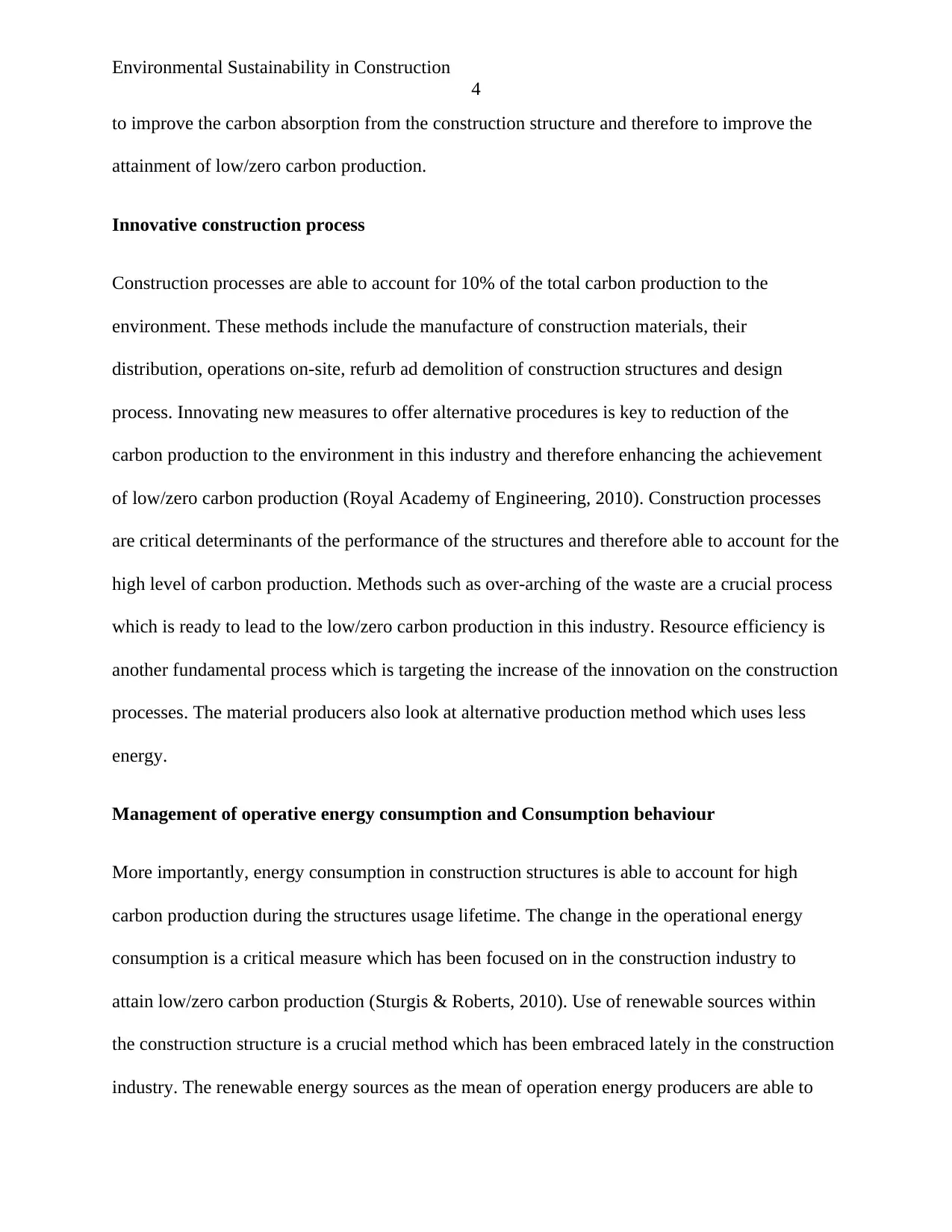
Environmental Sustainability in Construction
4
to improve the carbon absorption from the construction structure and therefore to improve the
attainment of low/zero carbon production.
Innovative construction process
Construction processes are able to account for 10% of the total carbon production to the
environment. These methods include the manufacture of construction materials, their
distribution, operations on-site, refurb ad demolition of construction structures and design
process. Innovating new measures to offer alternative procedures is key to reduction of the
carbon production to the environment in this industry and therefore enhancing the achievement
of low/zero carbon production (Royal Academy of Engineering, 2010). Construction processes
are critical determinants of the performance of the structures and therefore able to account for the
high level of carbon production. Methods such as over-arching of the waste are a crucial process
which is ready to lead to the low/zero carbon production in this industry. Resource efficiency is
another fundamental process which is targeting the increase of the innovation on the construction
processes. The material producers also look at alternative production method which uses less
energy.
Management of operative energy consumption and Consumption behaviour
More importantly, energy consumption in construction structures is able to account for high
carbon production during the structures usage lifetime. The change in the operational energy
consumption is a critical measure which has been focused on in the construction industry to
attain low/zero carbon production (Sturgis & Roberts, 2010). Use of renewable sources within
the construction structure is a crucial method which has been embraced lately in the construction
industry. The renewable energy sources as the mean of operation energy producers are able to
4
to improve the carbon absorption from the construction structure and therefore to improve the
attainment of low/zero carbon production.
Innovative construction process
Construction processes are able to account for 10% of the total carbon production to the
environment. These methods include the manufacture of construction materials, their
distribution, operations on-site, refurb ad demolition of construction structures and design
process. Innovating new measures to offer alternative procedures is key to reduction of the
carbon production to the environment in this industry and therefore enhancing the achievement
of low/zero carbon production (Royal Academy of Engineering, 2010). Construction processes
are critical determinants of the performance of the structures and therefore able to account for the
high level of carbon production. Methods such as over-arching of the waste are a crucial process
which is ready to lead to the low/zero carbon production in this industry. Resource efficiency is
another fundamental process which is targeting the increase of the innovation on the construction
processes. The material producers also look at alternative production method which uses less
energy.
Management of operative energy consumption and Consumption behaviour
More importantly, energy consumption in construction structures is able to account for high
carbon production during the structures usage lifetime. The change in the operational energy
consumption is a critical measure which has been focused on in the construction industry to
attain low/zero carbon production (Sturgis & Roberts, 2010). Use of renewable sources within
the construction structure is a crucial method which has been embraced lately in the construction
industry. The renewable energy sources as the mean of operation energy producers are able to
Paraphrase This Document
Need a fresh take? Get an instant paraphrase of this document with our AI Paraphraser
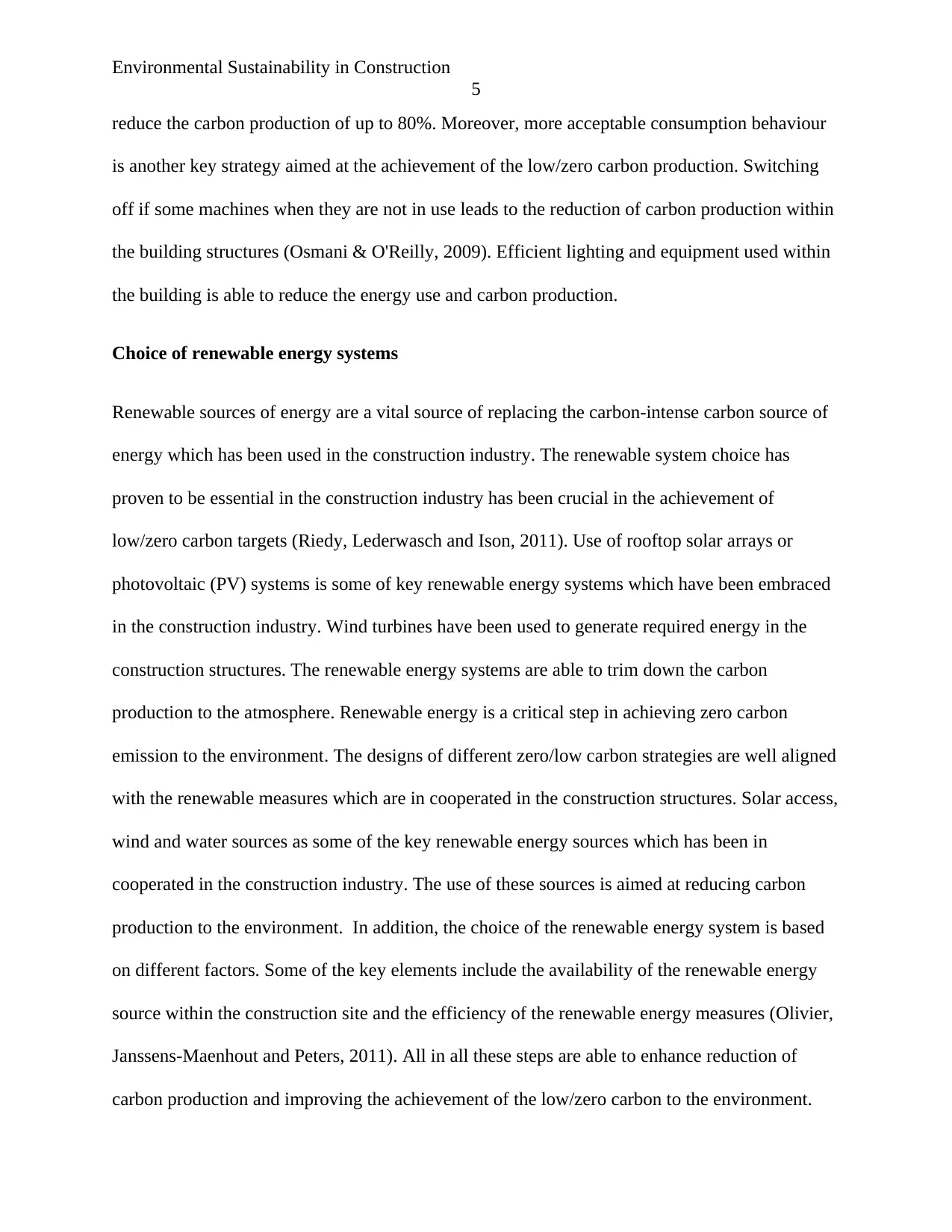
Environmental Sustainability in Construction
5
reduce the carbon production of up to 80%. Moreover, more acceptable consumption behaviour
is another key strategy aimed at the achievement of the low/zero carbon production. Switching
off if some machines when they are not in use leads to the reduction of carbon production within
the building structures (Osmani & O'Reilly, 2009). Efficient lighting and equipment used within
the building is able to reduce the energy use and carbon production.
Choice of renewable energy systems
Renewable sources of energy are a vital source of replacing the carbon-intense carbon source of
energy which has been used in the construction industry. The renewable system choice has
proven to be essential in the construction industry has been crucial in the achievement of
low/zero carbon targets (Riedy, Lederwasch and Ison, 2011). Use of rooftop solar arrays or
photovoltaic (PV) systems is some of key renewable energy systems which have been embraced
in the construction industry. Wind turbines have been used to generate required energy in the
construction structures. The renewable energy systems are able to trim down the carbon
production to the atmosphere. Renewable energy is a critical step in achieving zero carbon
emission to the environment. The designs of different zero/low carbon strategies are well aligned
with the renewable measures which are in cooperated in the construction structures. Solar access,
wind and water sources as some of the key renewable energy sources which has been in
cooperated in the construction industry. The use of these sources is aimed at reducing carbon
production to the environment. In addition, the choice of the renewable energy system is based
on different factors. Some of the key elements include the availability of the renewable energy
source within the construction site and the efficiency of the renewable energy measures (Olivier,
Janssens-Maenhout and Peters, 2011). All in all these steps are able to enhance reduction of
carbon production and improving the achievement of the low/zero carbon to the environment.
5
reduce the carbon production of up to 80%. Moreover, more acceptable consumption behaviour
is another key strategy aimed at the achievement of the low/zero carbon production. Switching
off if some machines when they are not in use leads to the reduction of carbon production within
the building structures (Osmani & O'Reilly, 2009). Efficient lighting and equipment used within
the building is able to reduce the energy use and carbon production.
Choice of renewable energy systems
Renewable sources of energy are a vital source of replacing the carbon-intense carbon source of
energy which has been used in the construction industry. The renewable system choice has
proven to be essential in the construction industry has been crucial in the achievement of
low/zero carbon targets (Riedy, Lederwasch and Ison, 2011). Use of rooftop solar arrays or
photovoltaic (PV) systems is some of key renewable energy systems which have been embraced
in the construction industry. Wind turbines have been used to generate required energy in the
construction structures. The renewable energy systems are able to trim down the carbon
production to the atmosphere. Renewable energy is a critical step in achieving zero carbon
emission to the environment. The designs of different zero/low carbon strategies are well aligned
with the renewable measures which are in cooperated in the construction structures. Solar access,
wind and water sources as some of the key renewable energy sources which has been in
cooperated in the construction industry. The use of these sources is aimed at reducing carbon
production to the environment. In addition, the choice of the renewable energy system is based
on different factors. Some of the key elements include the availability of the renewable energy
source within the construction site and the efficiency of the renewable energy measures (Olivier,
Janssens-Maenhout and Peters, 2011). All in all these steps are able to enhance reduction of
carbon production and improving the achievement of the low/zero carbon to the environment.
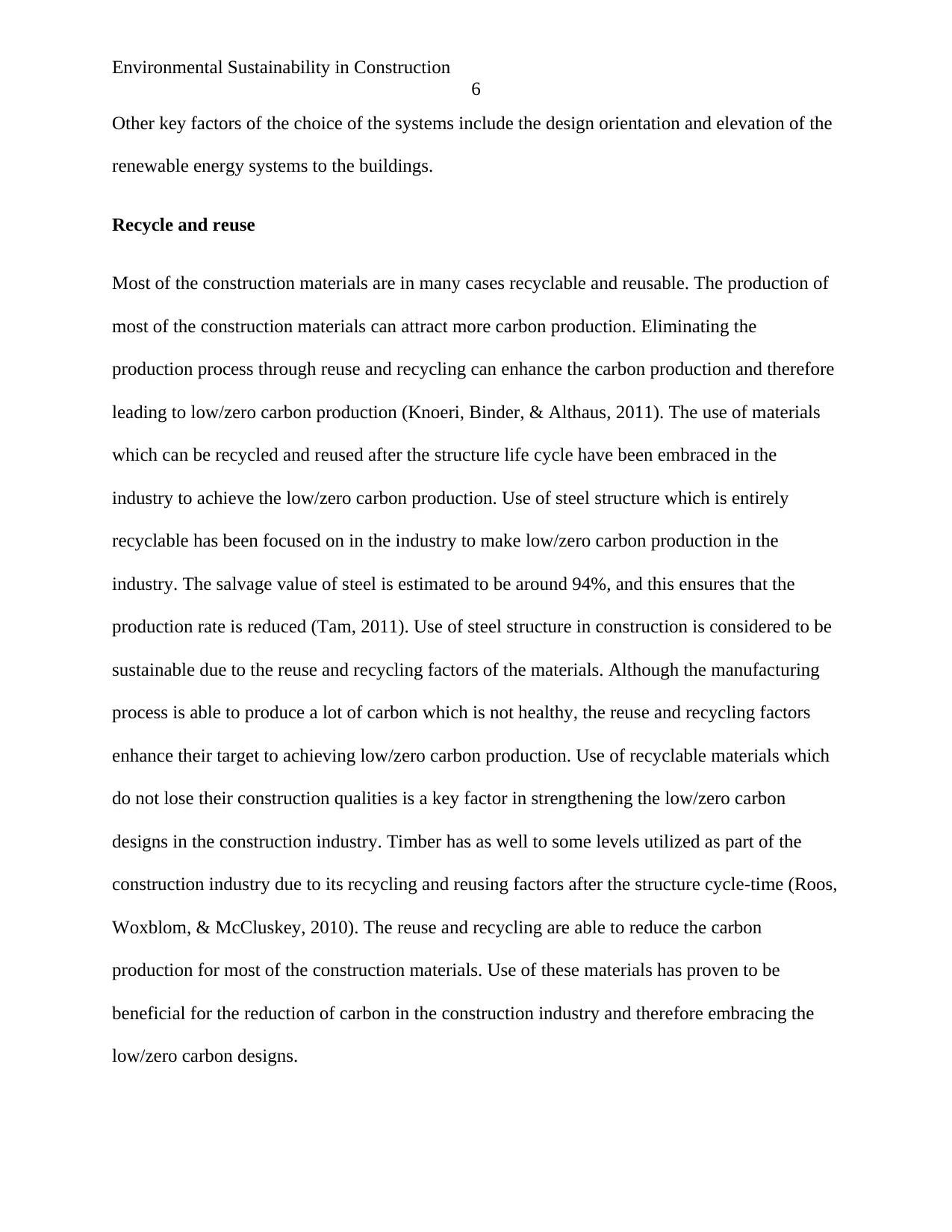
Environmental Sustainability in Construction
6
Other key factors of the choice of the systems include the design orientation and elevation of the
renewable energy systems to the buildings.
Recycle and reuse
Most of the construction materials are in many cases recyclable and reusable. The production of
most of the construction materials can attract more carbon production. Eliminating the
production process through reuse and recycling can enhance the carbon production and therefore
leading to low/zero carbon production (Knoeri, Binder, & Althaus, 2011). The use of materials
which can be recycled and reused after the structure life cycle have been embraced in the
industry to achieve the low/zero carbon production. Use of steel structure which is entirely
recyclable has been focused on in the industry to make low/zero carbon production in the
industry. The salvage value of steel is estimated to be around 94%, and this ensures that the
production rate is reduced (Tam, 2011). Use of steel structure in construction is considered to be
sustainable due to the reuse and recycling factors of the materials. Although the manufacturing
process is able to produce a lot of carbon which is not healthy, the reuse and recycling factors
enhance their target to achieving low/zero carbon production. Use of recyclable materials which
do not lose their construction qualities is a key factor in strengthening the low/zero carbon
designs in the construction industry. Timber has as well to some levels utilized as part of the
construction industry due to its recycling and reusing factors after the structure cycle-time (Roos,
Woxblom, & McCluskey, 2010). The reuse and recycling are able to reduce the carbon
production for most of the construction materials. Use of these materials has proven to be
beneficial for the reduction of carbon in the construction industry and therefore embracing the
low/zero carbon designs.
6
Other key factors of the choice of the systems include the design orientation and elevation of the
renewable energy systems to the buildings.
Recycle and reuse
Most of the construction materials are in many cases recyclable and reusable. The production of
most of the construction materials can attract more carbon production. Eliminating the
production process through reuse and recycling can enhance the carbon production and therefore
leading to low/zero carbon production (Knoeri, Binder, & Althaus, 2011). The use of materials
which can be recycled and reused after the structure life cycle have been embraced in the
industry to achieve the low/zero carbon production. Use of steel structure which is entirely
recyclable has been focused on in the industry to make low/zero carbon production in the
industry. The salvage value of steel is estimated to be around 94%, and this ensures that the
production rate is reduced (Tam, 2011). Use of steel structure in construction is considered to be
sustainable due to the reuse and recycling factors of the materials. Although the manufacturing
process is able to produce a lot of carbon which is not healthy, the reuse and recycling factors
enhance their target to achieving low/zero carbon production. Use of recyclable materials which
do not lose their construction qualities is a key factor in strengthening the low/zero carbon
designs in the construction industry. Timber has as well to some levels utilized as part of the
construction industry due to its recycling and reusing factors after the structure cycle-time (Roos,
Woxblom, & McCluskey, 2010). The reuse and recycling are able to reduce the carbon
production for most of the construction materials. Use of these materials has proven to be
beneficial for the reduction of carbon in the construction industry and therefore embracing the
low/zero carbon designs.
⊘ This is a preview!⊘
Do you want full access?
Subscribe today to unlock all pages.

Trusted by 1+ million students worldwide
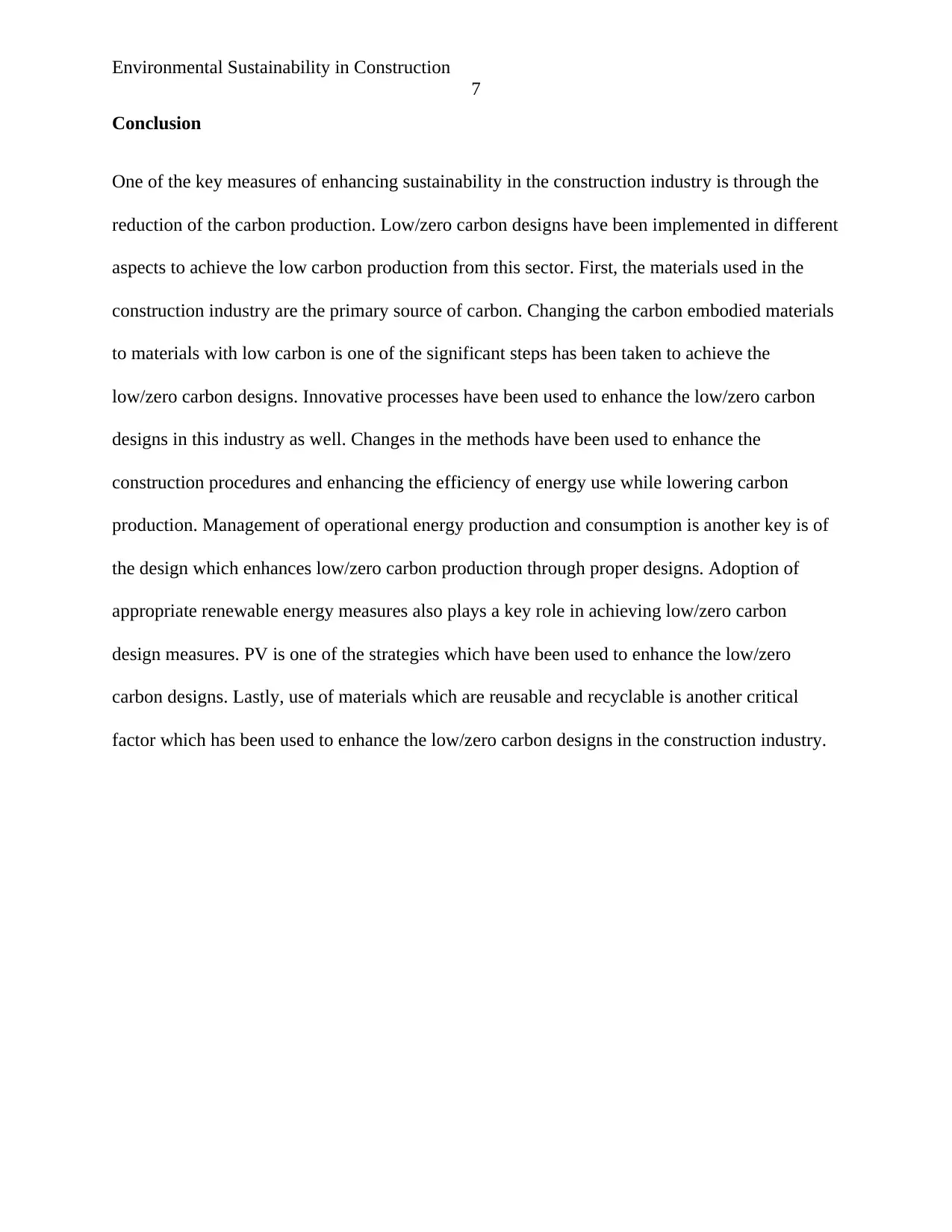
Environmental Sustainability in Construction
7
Conclusion
One of the key measures of enhancing sustainability in the construction industry is through the
reduction of the carbon production. Low/zero carbon designs have been implemented in different
aspects to achieve the low carbon production from this sector. First, the materials used in the
construction industry are the primary source of carbon. Changing the carbon embodied materials
to materials with low carbon is one of the significant steps has been taken to achieve the
low/zero carbon designs. Innovative processes have been used to enhance the low/zero carbon
designs in this industry as well. Changes in the methods have been used to enhance the
construction procedures and enhancing the efficiency of energy use while lowering carbon
production. Management of operational energy production and consumption is another key is of
the design which enhances low/zero carbon production through proper designs. Adoption of
appropriate renewable energy measures also plays a key role in achieving low/zero carbon
design measures. PV is one of the strategies which have been used to enhance the low/zero
carbon designs. Lastly, use of materials which are reusable and recyclable is another critical
factor which has been used to enhance the low/zero carbon designs in the construction industry.
7
Conclusion
One of the key measures of enhancing sustainability in the construction industry is through the
reduction of the carbon production. Low/zero carbon designs have been implemented in different
aspects to achieve the low carbon production from this sector. First, the materials used in the
construction industry are the primary source of carbon. Changing the carbon embodied materials
to materials with low carbon is one of the significant steps has been taken to achieve the
low/zero carbon designs. Innovative processes have been used to enhance the low/zero carbon
designs in this industry as well. Changes in the methods have been used to enhance the
construction procedures and enhancing the efficiency of energy use while lowering carbon
production. Management of operational energy production and consumption is another key is of
the design which enhances low/zero carbon production through proper designs. Adoption of
appropriate renewable energy measures also plays a key role in achieving low/zero carbon
design measures. PV is one of the strategies which have been used to enhance the low/zero
carbon designs. Lastly, use of materials which are reusable and recyclable is another critical
factor which has been used to enhance the low/zero carbon designs in the construction industry.
Paraphrase This Document
Need a fresh take? Get an instant paraphrase of this document with our AI Paraphraser
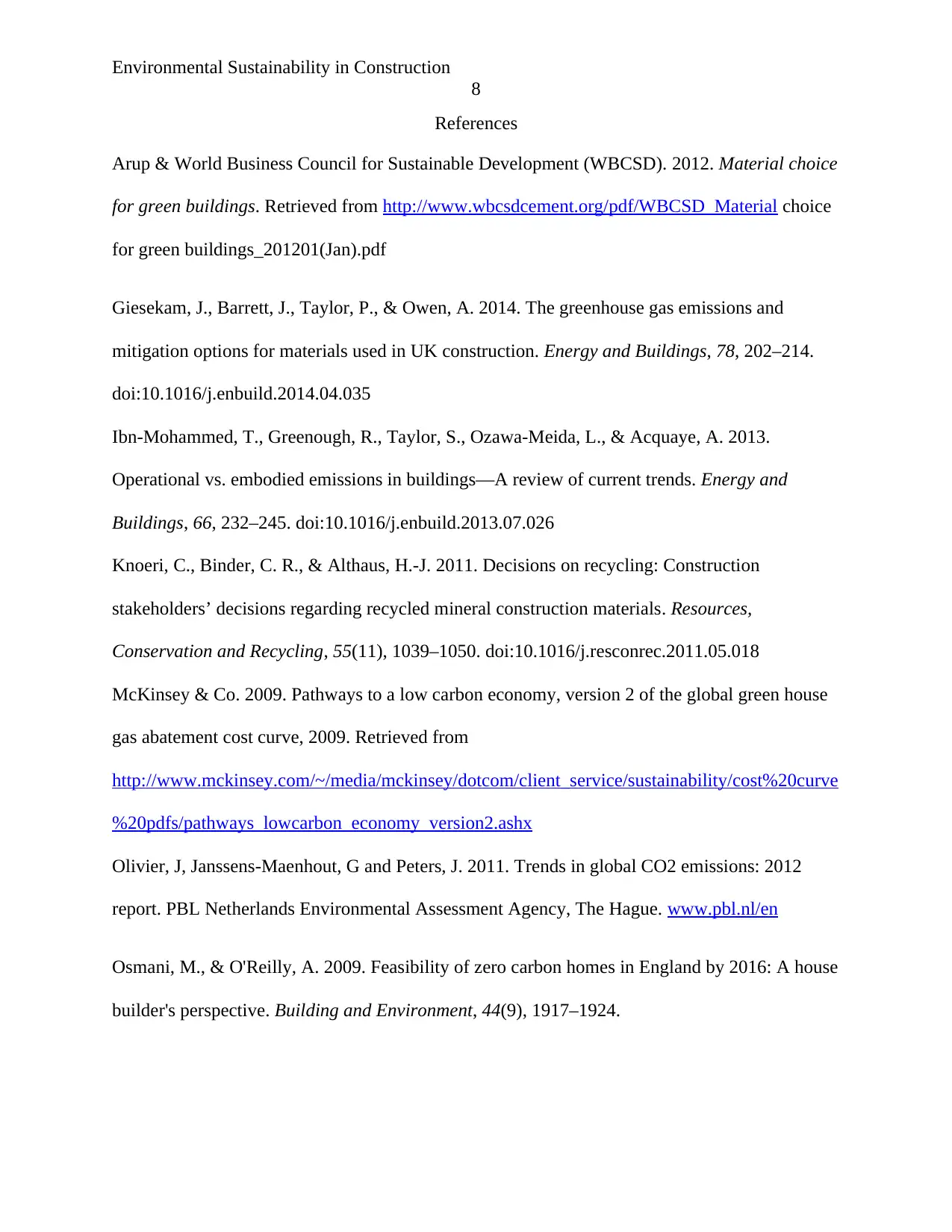
Environmental Sustainability in Construction
8
References
Arup & World Business Council for Sustainable Development (WBCSD). 2012. Material choice
for green buildings. Retrieved from http://www.wbcsdcement.org/pdf/WBCSD_Material choice
for green buildings_201201(Jan).pdf
Giesekam, J., Barrett, J., Taylor, P., & Owen, A. 2014. The greenhouse gas emissions and
mitigation options for materials used in UK construction. Energy and Buildings, 78, 202–214.
doi:10.1016/j.enbuild.2014.04.035
Ibn-Mohammed, T., Greenough, R., Taylor, S., Ozawa-Meida, L., & Acquaye, A. 2013.
Operational vs. embodied emissions in buildings—A review of current trends. Energy and
Buildings, 66, 232–245. doi:10.1016/j.enbuild.2013.07.026
Knoeri, C., Binder, C. R., & Althaus, H.-J. 2011. Decisions on recycling: Construction
stakeholders’ decisions regarding recycled mineral construction materials. Resources,
Conservation and Recycling, 55(11), 1039–1050. doi:10.1016/j.resconrec.2011.05.018
McKinsey & Co. 2009. Pathways to a low carbon economy, version 2 of the global green house
gas abatement cost curve, 2009. Retrieved from
http://www.mckinsey.com/~/media/mckinsey/dotcom/client_service/sustainability/cost%20curve
%20pdfs/pathways_lowcarbon_economy_version2.ashx
Olivier, J, Janssens-Maenhout, G and Peters, J. 2011. Trends in global CO2 emissions: 2012
report. PBL Netherlands Environmental Assessment Agency, The Hague. www.pbl.nl/en
Osmani, M., & O'Reilly, A. 2009. Feasibility of zero carbon homes in England by 2016: A house
builder's perspective. Building and Environment, 44(9), 1917–1924.
8
References
Arup & World Business Council for Sustainable Development (WBCSD). 2012. Material choice
for green buildings. Retrieved from http://www.wbcsdcement.org/pdf/WBCSD_Material choice
for green buildings_201201(Jan).pdf
Giesekam, J., Barrett, J., Taylor, P., & Owen, A. 2014. The greenhouse gas emissions and
mitigation options for materials used in UK construction. Energy and Buildings, 78, 202–214.
doi:10.1016/j.enbuild.2014.04.035
Ibn-Mohammed, T., Greenough, R., Taylor, S., Ozawa-Meida, L., & Acquaye, A. 2013.
Operational vs. embodied emissions in buildings—A review of current trends. Energy and
Buildings, 66, 232–245. doi:10.1016/j.enbuild.2013.07.026
Knoeri, C., Binder, C. R., & Althaus, H.-J. 2011. Decisions on recycling: Construction
stakeholders’ decisions regarding recycled mineral construction materials. Resources,
Conservation and Recycling, 55(11), 1039–1050. doi:10.1016/j.resconrec.2011.05.018
McKinsey & Co. 2009. Pathways to a low carbon economy, version 2 of the global green house
gas abatement cost curve, 2009. Retrieved from
http://www.mckinsey.com/~/media/mckinsey/dotcom/client_service/sustainability/cost%20curve
%20pdfs/pathways_lowcarbon_economy_version2.ashx
Olivier, J, Janssens-Maenhout, G and Peters, J. 2011. Trends in global CO2 emissions: 2012
report. PBL Netherlands Environmental Assessment Agency, The Hague. www.pbl.nl/en
Osmani, M., & O'Reilly, A. 2009. Feasibility of zero carbon homes in England by 2016: A house
builder's perspective. Building and Environment, 44(9), 1917–1924.
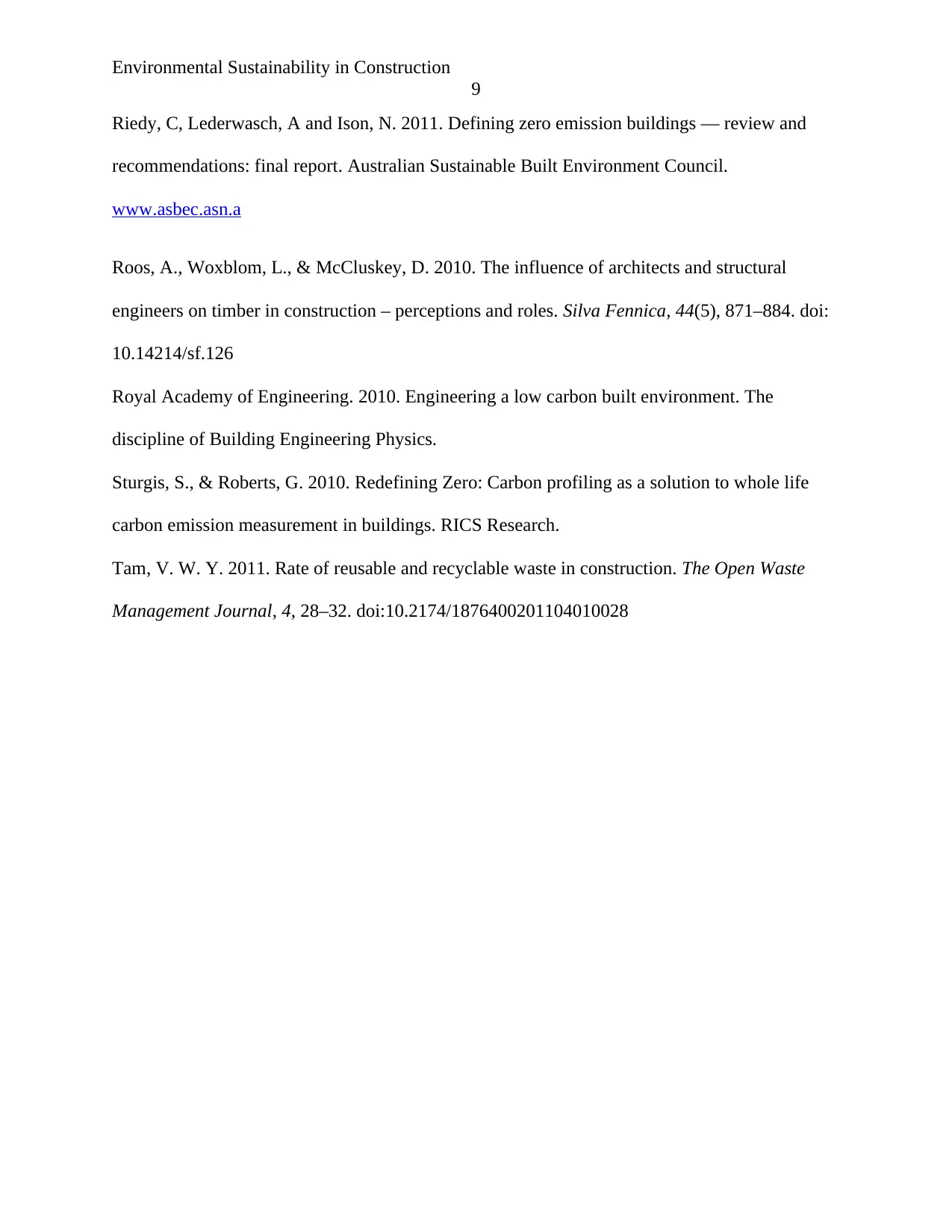
Environmental Sustainability in Construction
9
Riedy, C, Lederwasch, A and Ison, N. 2011. Defining zero emission buildings — review and
recommendations: final report. Australian Sustainable Built Environment Council.
www.asbec.asn.a
Roos, A., Woxblom, L., & McCluskey, D. 2010. The influence of architects and structural
engineers on timber in construction – perceptions and roles. Silva Fennica, 44(5), 871–884. doi:
10.14214/sf.126
Royal Academy of Engineering. 2010. Engineering a low carbon built environment. The
discipline of Building Engineering Physics.
Sturgis, S., & Roberts, G. 2010. Redefining Zero: Carbon profiling as a solution to whole life
carbon emission measurement in buildings. RICS Research.
Tam, V. W. Y. 2011. Rate of reusable and recyclable waste in construction. The Open Waste
Management Journal, 4, 28–32. doi:10.2174/1876400201104010028
9
Riedy, C, Lederwasch, A and Ison, N. 2011. Defining zero emission buildings — review and
recommendations: final report. Australian Sustainable Built Environment Council.
www.asbec.asn.a
Roos, A., Woxblom, L., & McCluskey, D. 2010. The influence of architects and structural
engineers on timber in construction – perceptions and roles. Silva Fennica, 44(5), 871–884. doi:
10.14214/sf.126
Royal Academy of Engineering. 2010. Engineering a low carbon built environment. The
discipline of Building Engineering Physics.
Sturgis, S., & Roberts, G. 2010. Redefining Zero: Carbon profiling as a solution to whole life
carbon emission measurement in buildings. RICS Research.
Tam, V. W. Y. 2011. Rate of reusable and recyclable waste in construction. The Open Waste
Management Journal, 4, 28–32. doi:10.2174/1876400201104010028
⊘ This is a preview!⊘
Do you want full access?
Subscribe today to unlock all pages.

Trusted by 1+ million students worldwide
1 out of 9
Related Documents
Your All-in-One AI-Powered Toolkit for Academic Success.
+13062052269
info@desklib.com
Available 24*7 on WhatsApp / Email
![[object Object]](/_next/static/media/star-bottom.7253800d.svg)
Unlock your academic potential
Copyright © 2020–2025 A2Z Services. All Rights Reserved. Developed and managed by ZUCOL.





